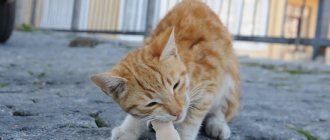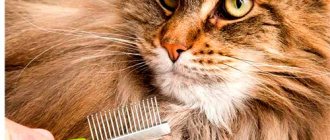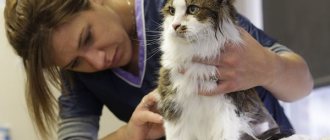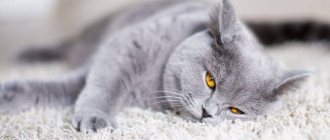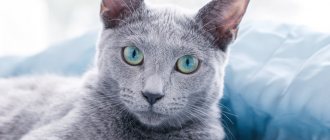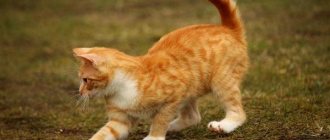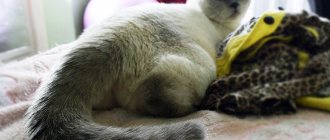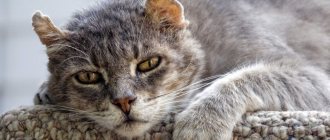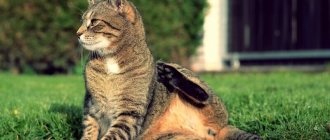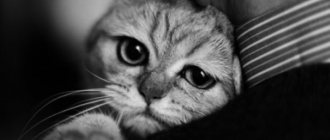Shedding is a normal process. Thanks to it, a gradual change of coat occurs. For example, if the animal is hot (summer is approaching or the heating season in the apartment).
Without shedding, the pet will be very hot, which is why some of the hairs fall out.
However, in some cases, such a change in coat is not associated with an increase in temperature in the cat’s environment.
Or the amount of hair falling out is too large. Then the owner should be wary, because severe shedding can be a symptom of a disease.
Physiology
At different periods of its existence, a cat moves differently. The resulting calories from a small kitten are spent on the growth of bones and muscles; the remaining calories are required for play.
The body of older cats may dry out due to age and for some other reasons, including:
- illnesses and stress;
- lack of vitamins;
- lost teeth;
- parasites.
Owners of older cats should closely monitor their condition and take them to the veterinarian if necessary.
What is the character of a Scottish Fold cat?
Scottish Folds are distinguished by their kind, calm and balanced character. Their lifestyle is quite measured, hyperactivity is usually not typical for them. You are unlikely to constantly find such a pet trying to climb onto the closet and over the curtains, or simply rushing briskly around the rooms. But this does not mean that Scottish Fold cats are absolutely passive and behave like plush toys. They are naturally quite curious and enthusiastically explore everything that surrounds them.
How Scottish Fold cats get along with adults
Representatives of this breed are very loyal and sincerely become attached to people. It is believed that they choose one object of adoration, but this is not always the case. Many Scots treat all family members equally warmly and single out someone especially based on their mood.
Scottish Folds readily show their emotions and love to communicate using meows and purrs. Demonstrating affection, they can literally follow a person around the apartment.
And in attempts to gain attention, they often show persistence and willfulness.
Most Scottish Fold cats are not very fond of being cuddled or picked up. Although depending on their mood they may well purr on their knees. They usually have nothing against stroking and other caresses.
How Scottish Fold cats get along with children
When communicating with children, purrs are patient and calm. Aggression is rarely shown, and to provoke it, you need to try very hard. They don’t always like too much fun and noisy games, so cats try to avoid such activities and sit on the sidelines.
Normal weight
On average, an adult animal should weigh from 3 to 8 kg. Such a cat drinks a lot of fluids, eats, and leads an active life.
The doctor determines the degree of fatness based on the following criteria:
- Exhaustion - the cat has no subcutaneous layer, protruding ribs, a retracted abdomen, and a thin, dense tail.
- Disadvantage - bones and ribs are visually visible, but there is already a small amount of fat. The cat's figure resembles an hourglass.
- The ideal is the presence of a thin subcutaneous layer, the ribs are not visible, but can be easily felt, the body size is proportional.
- Excess – under a thick layer of fat it is almost impossible to feel the bones. If you look at the cat from above, the back appears broad.
- Dangerous excess - bones cannot be felt, folds are present on all parts of the body.
Weight categories (table)
Below are the average weight categories of cats, from which you can determine what type the pet belongs to. However, it is worth taking into account the breed characteristics of cats.
- Underweight (wasting)
The ribs, joints and pelvic bones are clearly visible in both long-haired and short-haired cat breeds. Lack of fat layer in the chest area.
- Normal limit (thinness)
The ribs, joints and pelvic bones are visible, but only in short-haired breeds. The waist is clearly visible. There is a thin layer of fat in the chest area.
- Ideal weight
The ribs, joints and pelvic bones are not visible, but can be felt. Good proportions with a visible waist. There is a thin layer of fat in the chest and abdomen area.
- Overweight
The bones can be felt, but with great difficulty. The waist is difficult to distinguish. Fat layers are clearly palpable.
- Obesity
The bones cannot be felt due to the thick fat layer. The waist is not visible, the volume of the abdomen is significantly increased.
Why is a cat losing weight?
Pathology
If a cat eats a lot of food, but loses weight, there are several reasons:
- Presence of parasites . Worms or helminths can destroy a pet’s body from the inside. Even though the cat eats a lot of food, he continues to lose weight. A cat can become infected with helminths through dirty shoes, unwashed hands, or a dirty litter tray. You can get rid of parasites only by using special medications (treatment is carried out for at least six months).
- Diseases of internal organs. In diseases, there are two mechanisms for losing weight: lack of appetite and small doses of food consumed; and the process of digestion and absorption of food is disrupted. Endocrine diseases and pathologies of the digestive system lead to weight loss even when eating enough food. Associated symptoms are apathy, hair loss, diarrhea or constipation, etc.
- Stress. If an animal is stressed for a long time, it may lose weight even with a good appetite. If a cat is depressed, there may be no appetite at all, which also affects weight. Well, you need to wait for the cat to return to normal; neurological disorders require treatment and sedative medications.
- Infections. Infectious diseases are always accompanied by weight loss. All because the pet refuses food and water. The most common diseases are calcivirosis, rhinotracheitis, viral peritonitis, and panleukopenia. Often these diseases lead to the death of the pet.
- Tumors. Any malignant neoplasms can cause exhaustion in a cat. The animal has no appetite, hair falls out, and vomiting and diarrhea are possible.
- Allergy. If there is an allergic reaction, the cat may lose its sense of smell, making it difficult for it to perceive food. She will eat less and lose weight.
Don't forget about vaccinations. Most people believe that if an animal lives in a house, it cannot get sick. We can bring various viruses and infections with clothes or shoes, and cats living at home are more susceptible to them than street cats.
Physiological reasons
The conditions in which the animal is kept also matters. Here the reasons for weight loss can be:
- Mating period. During this time, pets may forget about food and lose body weight. At the end of the period of “festivities” the animal returns to normal. Changes in temperature. In winter, the cat accumulates fat; in summer, the fat is absorbed.
- Pregnancy . During pregnancy, a cat's appetite is always good, but as soon as she starts feeding kittens, she may lose weight. Everything will fall into place as soon as the feeding period is over.
- Feed. A cat's weight directly depends on the quality of food consumed. You cannot suddenly change her diet from dry food to homemade food. Due to menu changes, the pet always loses weight.
Most owners do not check the weight standards for their pet, taking into account its age and breed.
Causes of severe hair loss
- When the house is very hot, the air is too dry, and the light bulbs are almost constantly burning yellow, the cat sheds a lot. This is good and cozy for a person, but such conditions are not suitable for a pet. That is why molting is an opportunistic reaction.
- Often a cat sheds due to a lack of vitamins. This may be due to an incorrectly formulated diet, when there are practically no useful substances in the cat’s menu. This is either low quality food or the same products day after day. The fur is the first to react to hypovitaminosis; if you don’t catch it in time, much more serious complications will arise.
- Inappropriate cosmetics (shampoo, conditioner). Even a person experiences dandruff or hair loss if he uses cosmetics that are intended for a different type of hair and skin. Why can't a cat have the same reaction?
- Allergy. What does it develop into: food, medicine, household chemicals, plants, insect bites, dust and much more. But if a cat suffers from an allergic reaction, then it not only sheds, but also itches, and the nose and eyes begin to run. The cat will begin to sneeze, maybe even cough, and if the pet is not helped, every day it will get worse and worse.
- Parasites. Both cutaneous (fleas, lice) and intestinal helminths can lead to severe hair loss in a cat. If cutaneous worms act “directly,” then intestinal worms act “indirectly,” releasing toxins during their life. These toxins become an allergen for the body of a healthy pet.
- Fungi. The most well-known disease is microsporia (in common parlance - lichen). It can easily switch from a cat to a human. Of course, in this case, the cat does not shed completely, but only in certain areas, but still you should not write off this reason.
- Stress. Cats have plenty of external stimuli that lead to frustration. When animals are nervous, they shed heavily, may itch, sleep poorly, or, on the contrary, for a suspiciously long time and soundly (as if they have disconnected from the outside world). The cat may begin to lose weight.
- Skin disease, for example, dermatitis. Burns (chemical, solar, thermal) can also lead to increased hair loss (but only on the affected area of tissue, and not throughout the body).
- Inflammatory processes (hidden or obvious). With them, the animal’s body weakens, all efforts are spent on the pet’s recovery and restoration of the functions of the affected organs. Dull fur, which begins to thin out over time, can “tell” about the beginning of inflammation. The cat needs veterinary care, even if you think everything is fine with him.
- Predisposition. We must not forget about her. The most susceptible to heavy shedding is a short-haired cat, but with a very thick undercoat (for example, a British cat).
Dangerous and safe symptoms
You shouldn’t worry when your cat is thinner if he has:
- a certain breed - Bengal, Somali, Abyssinian;
- active lifestyle;
- age more than 10 years;
- change of lifestyle (moving, new litter box, new owner).
If the pet is in a calm state, but is suddenly losing weight, then the symptoms of the disease may be:
- drowsiness;
- At first the cat led an active life, then suddenly became lethargic and apathetic;
- loss of a large amount of hair;
- blood in excrement;
- nausea, constipation or diarrhea;
- heat;
- blanching of the mucous membranes.
Causes of exhaustion
Why do cats lose weight? There are a huge number of factors that can provoke exhaustion in pets.
Cachexia is usually caused by the following reasons:
- Dietary disorder.
The most common group of causes causing exhaustion in domestic animals. These factors include poor quality food, insufficient food for the pet, or a decrease in the palatability of the food (for example, with a low-protein diet).
Some cats have a lack of appetite, which causes sudden weight loss (anorexia). It usually occurs in response to severe stress or after a serious illness that causes disruption of vital processes.
- Metabolic disorders.
Parasites, tumors and viruses can cause serious metabolic disorders and disrupt the absorption of nutrients in the intestines. Often these consequences are observed in bacterial or fungal pathologies that are chronic in nature.
If your cat has had a large segment of intestine removed through surgery for certain reasons, this will invariably lead to a decrease in overall intestinal volume. Consequently, it absorbs much less of the nutrients required for optimal functioning of the body.
- Gastrointestinal dysfunction.
Disorders associated with the digestion of food occur with exocrine pancreatic insufficiency, diseases of the liver and biliary tract. These pathologies reduce the release of beneficial enzymes, which affects problems with the digestion of foods familiar to the cat.
- Loss of nutrients.
Diseases associated with huge losses of nutrients can cause rapid exhaustion of a cat. Among them: nephropathy, burns, enteropathy, as well as chronic bleeding.
Veterinarians cite a number of other reasons that can cause cachexia: neuromuscular disorders (paralysis of the esophagus, neurological problems, etc.), excessive consumption of calories by the body (during pregnancy, feeding kittens, etc.), viral infections, etc.
Treatment
In case of physiological reasons, no measures should be taken . But if there is a pathology, you need to get rid of it as soon as possible.
The cat must be shown to a veterinarian, who will order an examination, blood and stool tests, and x-rays. Once the picture becomes clear, the doctor may prescribe:
- medicines;
- vitamin supplements;
- change of diet;
- change of activity mode.
Cat losing weight due to parasites
Helminths are a common cause of weight loss. Having become interested in why a cat is losing weight with a good appetite, the owner should examine the contents of the tray and feel the pet’s belly. In the presence of parasites, swelling is observed. Helminths are not always visible in feces. But their presence is indicated by the dark color and liquid consistency of the stool. Additional signs of infection are:
- cough;
increased salivation and tear production;
vomit;
Frequent scratching or licking of the area under the tail.
In the first stages, the animal can only lose weight without loss of appetite. It is advisable to show him to a veterinarian to confirm the diagnosis. The doctor will also prescribe the most suitable drug. Pet stores offer deworming products in the form of pieces of dry food. Despite their relative cheapness and ease of administration, they may not be effective enough. The veterinarian will prescribe the medicine in the appropriate form.
If a cat has become infected with intestinal parasites, the owner must thoroughly rinse the cat's tray, bed and other favorite places of the pet. It is advisable for the whole family to take preventive medications against helminths. To reduce the risk of infection, it is advisable not to let your cat go outside.
Thyroid problems
By entering a query about why a cat is losing weight, a person will see various articles about hyperthyroidism. The disease is characterized by excessive production of thyroid hormones. A common cause of organ activity is a benign tumor. Appetite remains or even increases, but weight decreases. Additional signs of the development of pathology are:
- strong thirst;
excessive activity;
nausea;
amyotrophy;
diarrhea.
The disease can develop in any breed. This is an age-related disorder - less than 6-10% of cases occur in cats under 10 years of age.
The symptoms of hyperthyroidism are similar to those of some other conditions that develop in older adults. These include diabetes, inflammation and bowel cancer, and kidney failure. Problems with the thyroid gland are indicated by an increased level of the hormone T4 in the blood. But in about 10% of cats it may be at normal levels. To rule out diabetes or kidney problems, a complete blood and urine test is performed.
Left untreated, hyperthyroidism will lead to heart problems and death. But, with timely treatment, the cat returns to normal life. Surgery is a radical solution. Due to its structure, the tumor is easy to localize and remove. But anesthesia can be dangerous for an older cat. In such cases, the animal is prescribed methimazole (Tapazole). The drug normalizes the production of hormones and can be administered orally or applied to the skin of the ears. Your cat's blood will be drawn regularly to check the effect of the medication.
An alternative solution is radioactive iodine. The drug accumulates in the thyroid gland, destroying overactive tissue. No anesthesia or surgery is required. The cat is in the hospital for 10-14 days until the radioactive element is removed from the body.
Stress and other reasons why a cat can lose weight
Nervous tension is a common answer to the question why a cat doesn’t eat well and is losing weight. When under stress, an animal may retain its appetite. But the food is less digestible or the pet becomes nauseous. During an attack, the cat tends to hide, so the owner may not find traces of vomiting for a long time.
A good metabolism is the simplest and safest option. Cats, especially young ones, have fast metabolisms. A teenager will constantly want to eat, burning off calories with active games. True, in this case there is preservation, not weight loss.
Drying accompanies many diseases. It is necessary to find out why the cat is losing weight before starting treatment. Loss of weight and appetite may be caused by:
- toothache;
poor quality diet;
infectious peritonitis – the condition causes fever; Antibiotics do not help a sick cat;
cancer;
diabetes;
inflammatory processes.
A cat can lose weight by continuing to rush to the bowl if it is adjacent to other pets. Depending on its character, the animal does not have time to get to the food or cannot defend it
When keeping several cats (other pets), it is important to provide each with a convenient feeding place.
Losing weight is the dream of many people. Losing weight also benefits some pets. But, in both cases, it is necessary to monitor the trend of weight loss. A pet that is losing weight without losing its appetite is most likely sick. The most common cause is intestinal parasites or an overactive thyroid gland. The diagnosis is made by a veterinarian. It is worth consulting a doctor if a fat cat develops a waistline without changing its diet; or a lean pet has become even slimmer.
How to feed
If a cat loses body weight, the fault may lie with its owner, who incorrectly compiled his daily menu. There are rules, if followed, the cat’s weight will always be normal:
- Mixing dry food and homemade food is unacceptable. A cat develops one type of digestion, which is aimed either at “artificial” food or at natural food. When feeding dry food, your cat needs more fluid. If you change your diet frequently, your stomach will not be able to adapt in time, and you will begin to lose weight.
- Don't trust advertising. Such well-known brands as Whiskas and Kitiket are not a sign of quality. They are accessible to everyone, but contain attractions. These components are addictive. This is a serious burden for the pet’s stomach and intestines. You can extend your cat's life if you feed him food from a specialized store.
It is necessary to give preference to only one food option, otherwise, in addition to weight loss, various diseases may develop. This is natural food or branded industrial food.
ATTENTION! The packaging must be labeled holistic, premium and supreme. These are classes that indicate that all production standards have been met.
Diabetes
Diabetes mellitus is another common disease that affects cats. This endocrine disorder affects the pancreas's ability to produce insulin, a hormone needed to regulate blood glucose levels.
Signs of diabetes include weight loss, increased appetite, thirst and urination, and lethargy. Diabetes is usually treated with insulin and diet changes.
Other medications may be used. Some cats will even return to normal after several months of treatment.
Natural food
A cat's diet should contain two types of products: meat and fermented milk.
The meat diet must include beef, cut into small pieces. To get vitamins, you need to add vegetables or special additives to the meat. In pet stores you can buy special powders containing all the necessary vitamins.
ATTENTION! Fermented milk products include low-fat cottage cheese and kefir (1%). Cottage cheese should be on a cat’s menu 1-2 times a week.
What to do: how to help the cat?
Vitamins and nutritional supplements
The doctor will select the appropriate drug and regimen for taking it.
If a cat sheds in winter and summer, the process of shedding hair does not stop, it is better to take the animal for examination to a veterinary hospital. After carrying out the necessary tests, the veterinarian will be able to accurately determine the factor of heavy shedding. Often the secret lies in the lack of nutrients; in such cases, the pet is simply prescribed a course that includes vitamins, diet and a balanced diet. If the cat has no appetite, you can give brewer's yeast, which helps to gain weight, strengthens the coat and improves overall well-being.
Folk remedies
If you don’t trust store-bought medications, you can use advice from the people that will help stop many of the troubles associated with severe shedding. Examples:
- Home remedy for fleas and parasites. A strong decoction of wormwood, in which cats are bathed, will help get rid of uninvited residents.
- For your appetite. Egg yolk is added to your pet's food.
- Complex for skin and wool. Fish oil in capsules, which is added to food and drink.
- From wounds and ulcers. Homemade folk ointments based on medicinal herbs that can be made at home.
- Anti-hair loss products. Decoctions from plant components.
Grass
If a cat is losing weight, its diet must include green grass. It is necessary to normalize the functioning of the digestive system. The herb contains manganese, zinc, pantothenic acid, and various vitamins that help the body get rid of parasites and strengthen the immune system.
Forcing your cat to intentionally eat more food can be dangerous. Excess weight increases the load, reduces the pet's activity and leads to the development of various diseases.
If you constantly monitor changes in your pet, you can notice the symptoms of the disease in time.
IMPORTANT! Monitor the animal’s weight and lifestyle, feed it the right food. This will not only improve your well-being, but also prolong its life.
How to Prevent Weight Loss in Cats
You can prevent your cat from losing weight by regularly monitoring its body condition and visiting your veterinarian regularly for health checks.
Cats are good at hiding illness and injury, but a veterinarian can detect a problem before it gets out of control.
Be sure to tell your veterinarian about any changes in your cat's behavior. It is much easier to treat a health problem in its early stages than to wait until your cat is very sick.
Hyperthyroidism in cats
Kidney failure in cats
Diabetes in cats - symptoms and treatment of the disease
Inflammatory bowel disease in cats
Intestinal obstruction in cats
Cancer in cats: types, symptoms, prevention and treatment
Diagnostics
Due to the fact that there are many causes of exhaustion in cats, diagnosis is aimed at first excluding the most likely diseases - parasitic diseases, chronic kidney diseases, liver diseases, and food digestion disorders. In addition to a general examination and history taking, the veterinarian will also carry out the following diagnostic measures:
- Exclusion of parasites in the intestines using stool examination (for example, flotation).
- Complete clinical blood test to rule out anemia and inflammation.
- A complete biochemical blood test that will show the functioning of the liver, kidneys, levels of sugar, electrolytes and proteins in the blood.
- General clinical urine test - helps assess kidney function, detect infections, loss of protein from the kidneys.
- X-ray of the chest and abdominal cavity - to exclude a tumor process, foreign bodies in the gastrointestinal tract, free fluid in the chest or abdominal cavity and assess the size of internal organs.
- Ultrasound of the abdominal cavity - helps to evaluate the structure of the liver, kidneys, and examine the pancreas area. Ultrasound is used to search for tumors and foreign objects in the gastrointestinal tract, and to evaluate intestinal motility.
- Trypsin-like immunoreactivity test - used to diagnose certain diseases of the pancreas that lead to impaired digestion and absorption.
- Measuring thyroid hormone levels in older cats.
- Measurement of bile acid levels to assess liver function.
- Colonoscopy is an examination of the inner surface of the intestine with a thin endoscope, in which the condition of the intestinal mucosa is visually assessed, and sections of tissue are taken for analysis.
- An exploratory laparotomy is an operation that examines internal organs to make a diagnosis that was not made by other, less invasive tests.
Symptoms of exhaustion
Wasting in cats is easy to identify and is visually noticeable. The pet looks bony, so the spine is felt with your hands.
Other signs that indicate cachexia in cats:
- narrowing of the ribs
- loss of muscle mass,
- weakness and apathy,
- clear outline of the hind legs,
- unpleasant specific odor from the mouth,
- unquenchable thirst,
- changes in stool (for example, it becomes too dark and tarry),
- vomit.
When exhausted, the condition of the coat changes dramatically. It becomes much duller, breaks off and falls out, and in some places (usually on the sides) bald spots form that do not heal over time. In animals, wounds heal poorly, the body’s regenerative abilities decrease, and behavioral changes are observed (passivity, long sleep, etc.).
